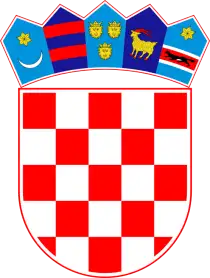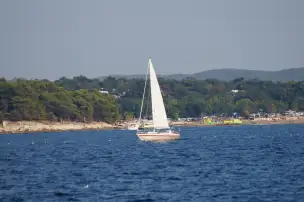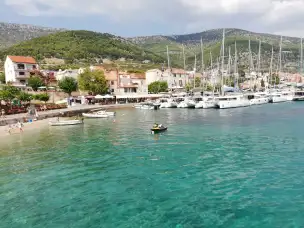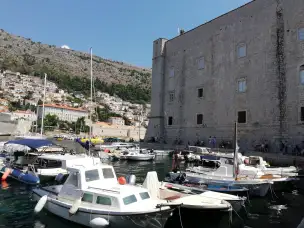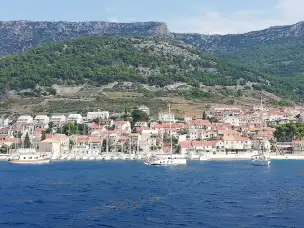Located in Southeastern Europe on the Adriatic coast, Croatia offers a wealth of attractions for both nature lovers and culture enthusiasts.
Dubrovnik – Known as the Pearl of the Adriatic, Dubrovnik is one of the most picturesque cities in Croatia. Its Old Town, surrounded by massive city walls, is a UNESCO World Heritage Site. It’s worth strolling through its streets, visiting the cathedral, the Franciscan Monastery, and enjoying the views from the defensive walls.
Split – The second-largest city in Croatia, famous for the historic Diocletian’s Palace, one of the best-preserved Roman palaces in the world. The city also offers beautiful beaches, lively markets, and a scenic waterfront.
Zagreb – The capital of Croatia is full of landmarks, parks, and cultural attractions. Highlights include the Old Town, Zagreb Cathedral, lively markets, and charming cafés. The city is also renowned for its many museums and art galleries.
Croatian cuisine is diverse, combining Mediterranean and Eastern European influences. Specialties such as seafood risotto, ćevapi (small grilled sausages), and local wines are especially popular.
Odkryj najlepsze loty do blisko sto miast na różnych kontynentach. Sprawdź aktualne ceny i promocje.
Sprawdź loty do blisko sto miast na różnych kontynentachGlagolitic Script – the First Slavic Alphabet
The Glagolitic script is the oldest known Slavic alphabet, created in the 9th century by St. Cyril (Constantine) for the Christianization of the Slavs. It preceded Cyrillic and was mainly used in Bulgaria, Croatia, and the territories of Great Moravia.
Croatia was one of the few countries that preserved Glagolitic for many centuries, even after it was replaced by Cyrillic in other Slavic lands. The Catholic Church in Croatia received papal permission to use Glagolitic in the liturgy. This was exceptional, since Latin was dominant in the Catholic world. Glagolitic was used in Croatia until the 19th century (for example, in monasteries on the island of Krk).
In the Witcher video game series by CD Projekt RED, Glagolitic appears as a visual element associated with magic and ancient knowledge. It is used in the stylization of magical writings and symbols. Some inscriptions visible on buildings or in books take on Glagolitic shapes. Since The Witcher draws heavily on Slavic culture, Glagolitic as an ancient script fits perfectly into a world full of mystery and magic.
Croatia – a Mecca for Sailors
Croatia is an absolute sailing mecca in Europe — and not just because of its sunshine and crystal-clear waters. Its coastline offers a combination of unique advantages that you can hardly find anywhere else in Europe.
Highlights of Croatia’s coast and waters:
- Thousands of islands – around 1,200 islands, including amazing spots like Hvar, Vis, the Kornati archipelago, Mljet, and Lastovo.
- Historic ports – the Old Towns of Split, Trogir, Dubrovnik, and Korčula are stunning, and you can moor right next to medieval city walls!
- National Parks – Kornati, Mljet – unique, wild landscapes, often accessible mainly to sailors.
- Secluded coves – hundreds of spots where you can anchor almost in solitude and dive straight into the sea from your boat.
If you hold a Polish motorboat skipper license or a yacht skipper license with a 2 NM coastal limit, in Croatia it may not always be automatically recognized — especially when chartering a boat commercially. In such cases, you are required to have a VHF radio operator’s license or obtain the Boat Skipper B certificate locally (a special version for foreigners, consisting of a short course and test).
Atmospheric Adriatic–Pannonian Transition
Have you ever noticed, while traveling through Croatia, that sudden change in scenery, when after just a few kilometers the landscape shifts abruptly from Mediterranean to something resembling central Poland?
This phenomenon is characteristic of Croatia and is called a climatic–vegetation transition — more precisely, the transition from a Mediterranean climate to a continental one. In professional terms, it is referred to as the Adriatic–Pannonian climatic transition.
Why does this happen?
Because the Dinaric Mountains (Biokovo, Velebit, and others) form a natural barrier:
- From the sea side, they trap moisture and warmth.
- Behind the mountains, the Pannonian climate begins — similar to what you find in Central Europe.
This is why, traveling just 10–20 km in Croatia, you can literally change both the climatic and vegetation zones — whereas in Poland, a similar change would require traveling hundreds of kilometers.
This transition is one reason why Croatia has three distinct geographic zones in such a small area:
- Istria and Dalmatia – Mediterranean climate
- Dinaric Mountains – mountain climate
- Pannonian Basin – continental climate, agricultural land



